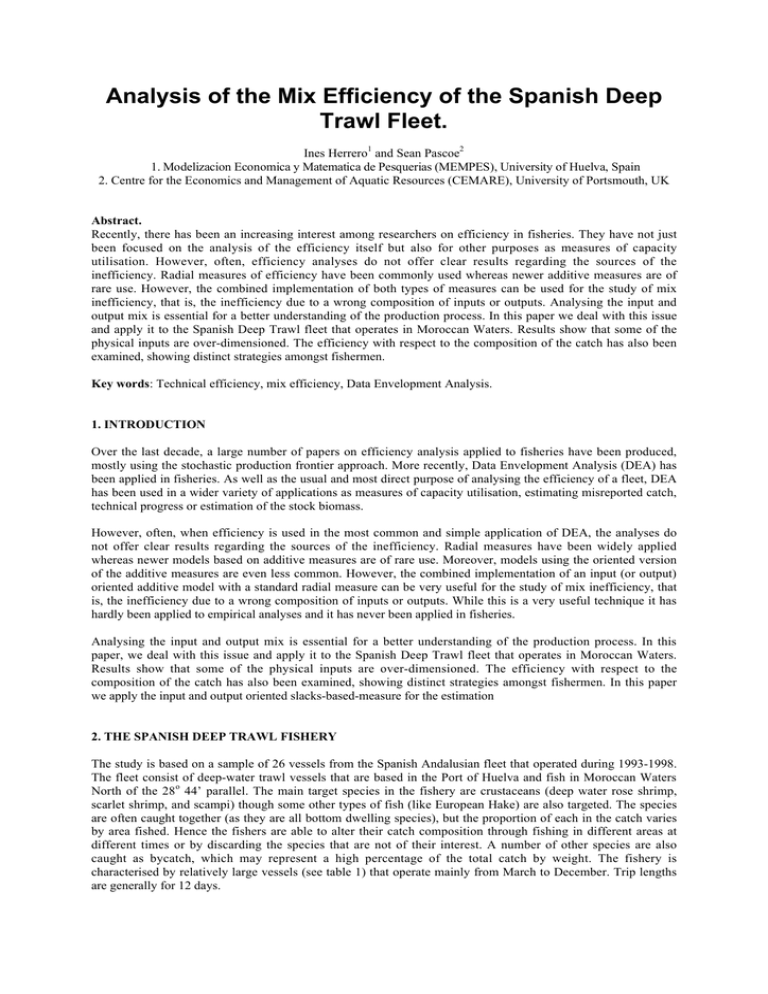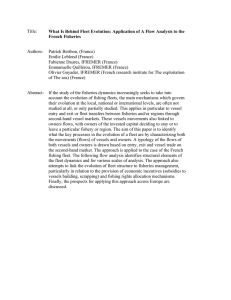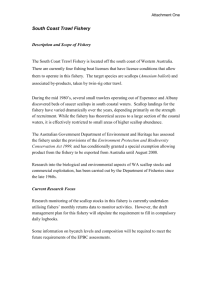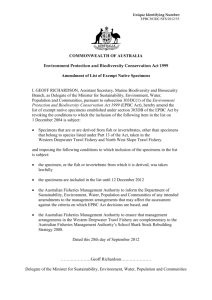Analysis of the Mix Efficiency of the Spanish Deep Trawl Fleet.
advertisement

Analysis of the Mix Efficiency of the Spanish Deep
Trawl Fleet.
Ines Herrero1 and Sean Pascoe2
1. Modelizacion Economica y Matematica de Pesquerias (MEMPES), University of Huelva, Spain
2. Centre for the Economics and Management of Aquatic Resources (CEMARE), University of Portsmouth, UK
Abstract.
Recently, there has been an increasing interest among researchers on efficiency in fisheries. They have not just
been focused on the analysis of the efficiency itself but also for other purposes as measures of capacity
utilisation. However, often, efficiency analyses do not offer clear results regarding the sources of the
inefficiency. Radial measures of efficiency have been commonly used whereas newer additive measures are of
rare use. However, the combined implementation of both types of measures can be used for the study of mix
inefficiency, that is, the inefficiency due to a wrong composition of inputs or outputs. Analysing the input and
output mix is essential for a better understanding of the production process. In this paper we deal with this issue
and apply it to the Spanish Deep Trawl fleet that operates in Moroccan Waters. Results show that some of the
physical inputs are over-dimensioned. The efficiency with respect to the composition of the catch has also been
examined, showing distinct strategies amongst fishermen.
Key words: Technical efficiency, mix efficiency, Data Envelopment Analysis.
1. INTRODUCTION
Over the last decade, a large number of papers on efficiency analysis applied to fisheries have been produced,
mostly using the stochastic production frontier approach. More recently, Data Envelopment Analysis (DEA) has
been applied in fisheries. As well as the usual and most direct purpose of analysing the efficiency of a fleet, DEA
has been used in a wider variety of applications as measures of capacity utilisation, estimating misreported catch,
technical progress or estimation of the stock biomass.
However, often, when efficiency is used in the most common and simple application of DEA, the analyses do
not offer clear results regarding the sources of the inefficiency. Radial measures have been widely applied
whereas newer models based on additive measures are of rare use. Moreover, models using the oriented version
of the additive measures are even less common. However, the combined implementation of an input (or output)
oriented additive model with a standard radial measure can be very useful for the study of mix inefficiency, that
is, the inefficiency due to a wrong composition of inputs or outputs. While this is a very useful technique it has
hardly been applied to empirical analyses and it has never been applied in fisheries.
Analysing the input and output mix is essential for a better understanding of the production process. In this
paper, we deal with this issue and apply it to the Spanish Deep Trawl fleet that operates in Moroccan Waters.
Results show that some of the physical inputs are over-dimensioned. The efficiency with respect to the
composition of the catch has also been examined, showing distinct strategies amongst fishermen. In this paper
we apply the input and output oriented slacks-based-measure for the estimation
2. THE SPANISH DEEP TRAWL FISHERY
The study is based on a sample of 26 vessels from the Spanish Andalusian fleet that operated during 1993-1998.
The fleet consist of deep-water trawl vessels that are based in the Port of Huelva and fish in Moroccan Waters
North of the 28o 44’ parallel. The main target species in the fishery are crustaceans (deep water rose shrimp,
scarlet shrimp, and scampi) though some other types of fish (like European Hake) are also targeted. The species
are often caught together (as they are all bottom dwelling species), but the proportion of each in the catch varies
by area fished. Hence the fishers are able to alter their catch composition through fishing in different areas at
different times or by discarding the species that are not of their interest. A number of other species are also
caught as bycatch, which may represent a high percentage of the total catch by weight. The fishery is
characterised by relatively large vessels (see table 1) that operate mainly from March to December. Trip lengths
are generally for 12 days.
Information on landings of individual vessels was obtained from the records of the fish auction market in
Huelva. Data on the physical characteristics of the boats were obtained from the fleet registers of the different
ship-owners’ associations and from the existing census of the Official Institutions. The database included daily
landing data from 1993 to 1998. Information on 1999 was also available though due to very few observations in
the data, was not included in the analysis. It was in November 1999, when this fishery stopped operating in the
area due to a lack of an agreement between the EU and Morocco. The last agreement took place in 1995 and
severe restrictions were imposed until November 1999. All data were aggregated into monthly observations.
Table 1. Technical characteristics of the fleet (Trawl fishery)
Mean
59
324
1.74
Gross Registered Tonnage (GRT)
Horsepower (HP)
Trips
Standard Deviation
15
83
0.7
This fishery was subject to a complex set of regulations1, which varied constantly over time depending on the
agreements with Morocco. Regulations restrict the capacity of these vessels, not allowing more than a certain
amount of GRT per year for the whole Spanish trawl fleet operating in Morocco2 (see table 2). Moreover, a
certain amount of taxes are imposed per GRT and they have been increasing over time (Barroso, 1998). On the
contrary, no restrictions on the engine power has ever been imposed. This resulted in a steady increase of the
average engine power of the fleet (which was 313 in 19853) and a decrease in the average capacity (which was
91 GRT in 19854). In the years considered, there was a close season imposed during January and February5.
Table 2. Maximum tonnage allowed for the Spanish North Trawl fishery operating in Moroccan Waters.
Max. tonnage
1/12/95-30/11/96
1/12/96-30/11/97
1/12/97-30/11/98
1/12/98-30/11/99
11,200
10,000
9,000
8,200
source: Barroso, 1998
We used monthly cross sectional data to avoid the inclusion of the stock variable. The key inputs in the model
were the size of the boat (represented by its gross registered tonnage, or GRT), the engine power of the boat (in
horsepower) and the number of trips each month. These three variables were included in the analysis of the
fishery by Garcia-Hoyo and Herrero-Chacon (1998). In our case, outputs were aggregated into two, crustaceans
and fish. The first one being more valuable than the second one.
3. ANALYSIS OF THE INPUT MIX EFFICIENCY
The use of a combination of an output (or input) oriented CCR model and an output (or input) oriented SlacksBased-Measure output model can be very useful for the determination of the output (or input) mix efficiency.
The Slacks-Based-Measure model (SBM model) was firstly developed by Tone (2001). While the SBM extends
the usual additive model in the sense that it possesses the unit invariant property, it does so at the cost of losing
the property of translation invariance.
The model is given by,
1
Some of these regulations include contracting a certain number of Moroccan crew members depending on the
size of the boat (and on the different agreements), the obligation of a certain number of landings in Moroccan
ports, the size of the mesh etc.
2
Note that this table includes figures from 1995 onwards. These figures could not be compared with those of the
previous agreements because it was not until 1995 when the North Trawl fishery was distinguished from other
types of trawl fisheries also operating in Morocco.
3
See García Hoyo and Herrero, 1998
4
See García Hoyo and Herrero, 1998
5
This information has been obtained from the fishermen´s guilds
THEME G: Theoretical and Empirical Bio-Economic Modelling
Analysis of the Mix Efficiency of the Spanish Deep Trawl Fleet
PAGE 2
min
1
1 − ∑ s ij−0 / xij0
I i
ρ=
1
1 + ∑ s rj+0 / y rj0
R r
s.t.
(1)
x0 = Xλ + s −
y0 = Yλ − s +
λ, s + , s− ≥ 0
where X={x ij} represent the i-th input (i=1,…,I) of DMU j and Y={y rj} represents the r-th input of DMU r
(r=1,…,R). The zero sub-index stands for the unit being evaluated and s-ijo and s+ijo are the slack variables
associated to xijo and yrjo respectively.
An analysis of the input mix-efficiency was carried out and applied to the fishery described above. The mix
efficiency is calculated by the combination of two different DEA models, an input oriented slacks based measure
(SBM) model (Tone, 2001) and an input oriented standard CCR model.
The input-oriented slacks-based-measure (SBM) model is defined in a similar way to the standard SBM model
above though minimising only the numerator (Tone, 2001), that is,
min
1
ρ in = 1 − ∑ si− / xi0
I i
s.t.
x0 = Xλ + s −
y0 = Yλ − s +
λ, s + , s − ≥ 0
(2)
The optimal value, ρin , verifies that ρ ≤ ρ in ≤ θin, where θin is the optimal solution to the standard CCR inputoriented model and ρ is the solution to the standard SBM model. The equality ρ in =θ in holds if the optimal
solution to the CCR model has zero slacks for the unit under evaluation. Moreover, a CCR-input efficient unit is
a SBM-input efficient unit and vice-versa.
Whereas θin represents the radial contraction of the inputs to make a unit efficient, the value of ρin includes not
only that radial measure but also a measure of the slack variables. The input-oriented mix efficiency measure for
a given unit is then defined as (Cooper, Seiford and Tone, 2000),
Input mix inefficiency (IMI) = ρin /θin
(3)
This value is bounded by 0 and 1 and represents a measure of a wrong input composition. A value equal to 1 is
associated to a unit that has a right composition of inputs. Moreover, the study of the standardised slack variables
(by their associated inputs) can provide a measure of the proportional contribution of each of the inputs into the
inefficiency of the unit being evaluated.
In order to study the relation between the two main physical inputs of the vessels (volume and power) and the
number of trips, the mix-efficiency was calculated using those three inputs. The total value of the two different
groups of species was used as outputs. Results showed an average input mix-efficiency score of 0.86, with a
standard deviation of 0.14. More than 68% of the units were mix-inefficient, meaning that they had some
positive slack variables in the CCR model.
THEME G: Theoretical and Empirical Bio-Economic Modelling
Analysis of the Mix Efficiency of the Spanish Deep Trawl Fleet
PAGE 3
When the standardised slack variables of the input-oriented SBM model were analysed, it was concluded that
approximately 42% of the total corresponded to the standardised slack variable associated to the engine power of
the vessels, 37% to the standardised slack variable associated to the volume and 20% to the number of trips.
These results suggest that some of the inputs are under-utilised, especially the engine power so that in most of
the cases as the majority of the vessels could get the same amount of output not just by radially reducing its
inputs but also by an extra reduction of some of them.
Previous studies of this fishery for 1985 and 1986 (Garcia-Hoyo and Herrero, 1998), using stochastic production
functions, showed that the elasticity associated with the engine power was higher than the elasticity associated
with the boat size whereas results of this study showed that in many cases a higher decrease in the power of the
vessels is needed to reach efficiency than in the level of the volume or in the number of trips and agree with
recent studies (work in progress) where it is shown that the elasticity associated with the power of the engines
have decreased over time for this fishery. The reason could be that the average engine power in 1985 and 1986
was lower than for the period under studied in this analysis (1993-1998). The policy management is based on
regulations on the capacity whereas the engines power of the vessels is not under any control. This has brought
about an increase in the engine power since the late eighties whereas the average vessel size has been reduced6.
This has also implied a change in the roles of the associated elasticities. Currently, the engine power of the
vessels seem to be under-utilised and a better combination of the inputs would be able to be obtained if the
regulations had been more proportionate regarding both physical inputs.
As a consequence, it could be concluded that a management system based in the control of just some of the
inputs can bring about either an expansion of the inputs that are left out of the control of the managers producing
the reverse effect, more efficient boats, as it seemed to happen during the first years after the regulations were
imposed and finally, the fleet can get to a point in which the non-controlled inputs reach too high levels as it
seems to have happened in the last few years. Hence, for an adequate management of the fishing resources and
of the productive inputs it seems necessary to establish a management system that control not just some but all
the inputs that are involved in the production process.
A similar analysis was carried out to study the output mix efficiency, that is the inefficiency due to a wrong
composition of the outputs. Assuming profit maximising behaviour, it is expected that fishers would aim to
maximise their revenue per trip. The proportion in the catch of the different species may results in higher or
lower benefits. With a mix of high value and low value species, high revenue may be derived from essentially a
low quantity of catch and vice versa. Some studies7 have studied the output mix efficiency by the comparison of
the results of the efficiency analysis when using catch as output and the results when using value of the catch.
Boats that appear inefficient when considering the total quantity of output may, in fact, be highly efficient when
considering the revenue derived from the catch. However, boats with similar value and catch efficiency may
present some mix inefficiency value which can not be detected. An output mix efficiency analysis of the vessels
using the combination of two different DEA models can provide useful information on the behaviour of the
fishers and information on the sources of the output mix inefficiency.
This analysis is similar to the previous one where the input-oriented models are substituted by the output
oriented versions. For the SBM model this is equivalent to maximising the denominator of the original model
(Tone, 2001),
max
ρ out = 1 +
1
∑ s rj+ / x rj0
R r 0
s.t.
x 0 = Xλ + s −
y 0 = Yλ − s +
λ, s + , s − ≥ 0
6
(4)
This is due to the introduction of new vessels in the fishery that are smaller in volume to agree with the
regulations. Fishermen have tried to “compensate” the decrease in the volume with an increase in the engine
power.
7
This is work in progress
THEME G: Theoretical and Empirical Bio-Economic Modelling
Analysis of the Mix Efficiency of the Spanish Deep Trawl Fleet
PAGE 4
In this case the output mix inefficiency is given by:
Output mix inefficiency (OMI) = θout /ρout
(5)
This value is bounded by 0 and 1 and represents a measure of a wrong output composition.
Results showed an average value of the output mix inefficiency of 0.82, with a standard deviation of 0.21. More
than 66% of the units were output mix inefficient. We got an interesting result as the percentage of the average
slack variable associated to fish (60%) was higher than the slack variable associated to seafood (40%). This can
be explained by the fact that even if shellfish is generally composed of higher price species (around 3 times
more), probably other fish species can be obtained in bigger quantities when using the same effort levels
(producing higher values). Hence, an appropriate output mix does not always has to be focused just on the higher
price species.
4. CONCLUSIONS
In this paper we have analysed the input and output mix efficiency of the vessels that operated in the South
Atlantic deep trawl fishery during the period 1993-1998. While this is a very useful technique it has hardly been
applied in empirical analyses and it has never been applied in fisheries before.
Regulations on the fishery under analysis have traditionally been of high complexity. However, they just control
two of the main physical inputs (time spent fishing and volume) whereas the engine power of the vessels is out
of any control. As this was the only uncontrolled main input, the fleet seemed to turn to an increase of this input
to compensate the lack of volume. However, as this input seemed to be under-utilised the increase in the volume
brought about an increase in the efficiency of the vessel (Garcia-Hoyo and Herrero, 1998). While the intention of
the regulations were the control of the already over-exploited fishing grounds, they got the reverse result, an
increase in the vessels efficiency (and, as a consequence, an increase in the over-exploitation of the resource).
However, years later, it seems that an over-dimension of the engine power of the vessels has been produced and
it is currently being under-utilised.
Understanding the composition of the inputs and outputs of the production process is a key point for
understanding the production process and for the optimal management system of the fishery. It seems important
that fishery managers pay attention to the control of every main input involved in each fishery to avoid either a
reverse effect (with vessels being more efficient and over-exploiting the fishing grounds) or to avoid the fleet
over investing in some inputs that are useless to be expanded as they are not producing any increase in the
benefits of the vessels.
A similar analysis has been carried out to analyse the mix efficiency regarding the different composition of the
captures. Results show that the optimal species composition does not always has to result in increasing the
higher price species.
5. ACKNOWLEDGEMENTS
The study has been carried out with the financial support of the Commission of the European Communities Fifth
Framework programme, QLK5-CT1999-01295, “Technical efficiency in EU fisheries: implications for
monitoring and management through effort controls”.
6. REFERENCES
Barroso, D. La Flota Pesquera Onubense en Marruecos. Working Paper. University of Huelva (in Spanish), 1998
Cooper, W.W., Seiford, L.M., Tone, K. Data Envelopment Analysis. A comprehensive text with models,
applications, references and DEA-Solver Software. Kluwer Academic Publishers, 2000.
Garcia-Hoyo, J.J., Herrero, I., 1998. The production function for the Spanish trawl fleet fishing in Moroccan
Waters. In Eide, A. and Vassdal, T. (Eds) IIFET’98 Proceedings, Norwegian College of Fisheries
Science, Tromso, 374-379.
THEME G: Theoretical and Empirical Bio-Economic Modelling
Analysis of the Mix Efficiency of the Spanish Deep Trawl Fleet
PAGE 5
Pascoe, S., and Herrero, I., Estimation of Stock Indexes Using DEA. XIII EAFE Conference, Salerno, 18-20
April, 2001. [available from: www.eafe-fish.org/conferences/html/salerno/salerno%20conference.htm]
Tone, K.. A slacks-based Measure of Efficiency in Data Envelopment Analysis. European Journal of
Operational Research, 130:498-509, 2001.
THEME G: Theoretical and Empirical Bio-Economic Modelling
Analysis of the Mix Efficiency of the Spanish Deep Trawl Fleet
PAGE 6







